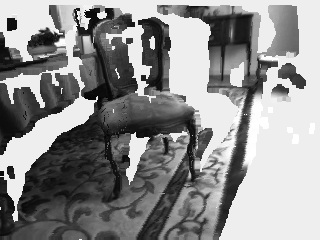Difference between revisions of "Example Stereo Disparity 3D"
From BoofCV
Jump to navigationJump to searchm |
m |
||
| Line 8: | Line 8: | ||
Example Code: | Example Code: | ||
* [https://github.com/lessthanoptimal/BoofCV/blob/v0. | * [https://github.com/lessthanoptimal/BoofCV/blob/v0.35/examples/src/main/java/boofcv/examples/stereo/ExampleStereoDisparity3D.java ExampleStereoDisparity3D.java] | ||
Concepts: | Concepts: | ||
| Line 33: | Line 33: | ||
public class ExampleStereoDisparity3D { | public class ExampleStereoDisparity3D { | ||
// Specifies what | // Specifies what disparity values are considered | ||
public static final int minDisparity = 10; | |||
public static final int rangeDisparity = 60; | |||
public static final int minDisparity = | |||
public static final int rangeDisparity = | |||
public static void main( String args[] ) { | public static void main( String args[] ) { | ||
| Line 56: | Line 52: | ||
GrayU8 distLeft = ConvertBufferedImage.convertFrom(origLeft, (GrayU8) null); | GrayU8 distLeft = ConvertBufferedImage.convertFrom(origLeft, (GrayU8) null); | ||
GrayU8 distRight = ConvertBufferedImage.convertFrom(origRight,(GrayU8)null); | GrayU8 distRight = ConvertBufferedImage.convertFrom(origRight,(GrayU8)null); | ||
// rectify images and compute disparity | // rectify images and compute disparity | ||
GrayU8 rectLeft = | GrayU8 rectLeft = distLeft.createSameShape(); | ||
GrayU8 rectRight = | GrayU8 rectRight = distRight.createSameShape(); | ||
RectifyCalibrated rectAlg = ExampleStereoDisparity.rectify( | RectifyCalibrated rectAlg = ExampleStereoDisparity.rectify(distLeft,distRight,param,rectLeft,rectRight); | ||
// GrayU8 disparity = ExampleStereoDisparity.denseDisparity(rectLeft, rectRight, 3,minDisparity, | // GrayU8 disparity = ExampleStereoDisparity.denseDisparity(rectLeft, rectRight, 3,minDisparity, rangeDisparity); | ||
GrayF32 disparity = ExampleStereoDisparity.denseDisparitySubpixel(rectLeft, rectRight, | GrayF32 disparity = ExampleStereoDisparity.denseDisparitySubpixel( | ||
rectLeft, rectRight, 5, minDisparity, rangeDisparity); | |||
// ------------- Convert disparity image into a 3D point cloud | // ------------- Convert disparity image into a 3D point cloud | ||
| Line 96: | Line 82: | ||
pcv.setTranslationStep(1.5); | pcv.setTranslationStep(1.5); | ||
Point3D_F64 pointRect = new Point3D_F64(); | Point3D_F64 pointRect = new Point3D_F64(); | ||
Point3D_F64 pointLeft = new Point3D_F64(); | Point3D_F64 pointLeft = new Point3D_F64(); | ||
| Line 133: | Line 118: | ||
// Configure the display | // Configure the display | ||
// pcv. | // pcv.setFog(true); | ||
// pcv. | // pcv.setClipDistance(baseline*45); | ||
// PeriodicColorizer colorizer = new TwoAxisRgbPlane.Z_XY(4.0); | |||
// colorizer.setPeriod(baseline*5); | |||
// pcv.setColorizer(colorizer); // sometimes pseudo color can be easier to view | |||
pcv.setDotSize(1); | |||
pcv.setCameraHFov(PerspectiveOps.computeHFov(param.left)); | pcv.setCameraHFov(PerspectiveOps.computeHFov(param.left)); | ||
pcv.setCameraToWorld(cameraToWorld); | pcv.setCameraToWorld(cameraToWorld); | ||
| Line 141: | Line 130: | ||
// display the results. Click and drag to change point cloud camera | // display the results. Click and drag to change point cloud camera | ||
BufferedImage visualized = VisualizeImageData.disparity(disparity, null, | BufferedImage visualized = VisualizeImageData.disparity(disparity, null,rangeDisparity,0); | ||
ShowImages.showWindow(visualized,"Disparity", true); | ShowImages.showWindow(visualized,"Disparity", true); | ||
ShowImages.showWindow(viewer,"Point Cloud", true); | ShowImages.showWindow(viewer,"Point Cloud", true); | ||
Revision as of 17:11, 23 December 2019
An additional example for stereo disparity. This one shows you how to properly resize input images and convert the disparity image into a 3D point cloud.
Example Code:
Concepts:
- Stereo disparity
- Point clouds
Relevant Applets:
Related Examples:
Example Code
/**
* Expanding upon ExampleStereoDisparity, this example demonstrates how to rescale an image for stereo processing and
* then compute its 3D point cloud. Images are often rescaled to improve speed and some times quality. Creating
* 3D point clouds from disparity images is easy and well documented in the literature, but there are some nuances
* to it.
*
* @author Peter Abeles
*/
public class ExampleStereoDisparity3D {
// Specifies what disparity values are considered
public static final int minDisparity = 10;
public static final int rangeDisparity = 60;
public static void main( String args[] ) {
// ------------- Compute Stereo Correspondence
// Load camera images and stereo camera parameters
String calibDir = UtilIO.pathExample("calibration/stereo/Bumblebee2_Chess/");
String imageDir = UtilIO.pathExample("stereo/");
StereoParameters param = CalibrationIO.load(new File(calibDir , "stereo.yaml"));
// load and convert images into a BoofCV format
BufferedImage origLeft = UtilImageIO.loadImage(imageDir , "chair01_left.jpg");
BufferedImage origRight = UtilImageIO.loadImage(imageDir , "chair01_right.jpg");
GrayU8 distLeft = ConvertBufferedImage.convertFrom(origLeft, (GrayU8) null);
GrayU8 distRight = ConvertBufferedImage.convertFrom(origRight,(GrayU8)null);
// rectify images and compute disparity
GrayU8 rectLeft = distLeft.createSameShape();
GrayU8 rectRight = distRight.createSameShape();
RectifyCalibrated rectAlg = ExampleStereoDisparity.rectify(distLeft,distRight,param,rectLeft,rectRight);
// GrayU8 disparity = ExampleStereoDisparity.denseDisparity(rectLeft, rectRight, 3,minDisparity, rangeDisparity);
GrayF32 disparity = ExampleStereoDisparity.denseDisparitySubpixel(
rectLeft, rectRight, 5, minDisparity, rangeDisparity);
// ------------- Convert disparity image into a 3D point cloud
// The point cloud will be in the left cameras reference frame
DMatrixRMaj rectK = rectAlg.getCalibrationMatrix();
DMatrixRMaj rectR = rectAlg.getRectifiedRotation();
// extract intrinsic parameters from rectified camera
double baseline = param.getBaseline()*0.1;
double fx = rectK.get(0,0);
double fy = rectK.get(1,1);
double cx = rectK.get(0,2);
double cy = rectK.get(1,2);
double maxZ = baseline*100;
// Iterate through each pixel in disparity image and compute its 3D coordinate
PointCloudViewer pcv = VisualizeData.createPointCloudViewer();
pcv.setTranslationStep(1.5);
Point3D_F64 pointRect = new Point3D_F64();
Point3D_F64 pointLeft = new Point3D_F64();
for( int y = 0; y < disparity.height; y++ ) {
for( int x = 0; x < disparity.width; x++ ) {
double d = disparity.unsafe_get(x,y) + minDisparity;
// skip over pixels were no correspondence was found
if( d >= rangeDisparity || d <= 0 )
continue;
// Coordinate in rectified camera frame
pointRect.z = baseline*fx/d;
pointRect.x = pointRect.z*(x - cx)/fx;
pointRect.y = pointRect.z*(y - cy)/fy;
// prune points which are likely to be noise
if( pointRect.z >= maxZ )
continue;
// rotate into the original left camera frame
GeometryMath_F64.multTran(rectR, pointRect, pointLeft);
// add pixel to the view for display purposes and sets its gray scale value
int v = rectLeft.unsafe_get(x, y);
pcv.addPoint(pointLeft.x,pointLeft.y,pointLeft.z,v << 16 | v << 8 | v);
// temp.add( pointLeft.copy() );
}
}
// move it back a bit to make the 3D structure more apparent
Se3_F64 cameraToWorld = new Se3_F64();
cameraToWorld.T.z = -baseline*5;
cameraToWorld.T.x = baseline*12;
ConvertRotation3D_F64.eulerToMatrix(EulerType.XYZ,0.1,-0.4,0,cameraToWorld.R);
// Configure the display
// pcv.setFog(true);
// pcv.setClipDistance(baseline*45);
// PeriodicColorizer colorizer = new TwoAxisRgbPlane.Z_XY(4.0);
// colorizer.setPeriod(baseline*5);
// pcv.setColorizer(colorizer); // sometimes pseudo color can be easier to view
pcv.setDotSize(1);
pcv.setCameraHFov(PerspectiveOps.computeHFov(param.left));
pcv.setCameraToWorld(cameraToWorld);
JComponent viewer = pcv.getComponent();
viewer.setPreferredSize(new Dimension(600,600*param.left.height/param.left.width));
// display the results. Click and drag to change point cloud camera
BufferedImage visualized = VisualizeImageData.disparity(disparity, null,rangeDisparity,0);
ShowImages.showWindow(visualized,"Disparity", true);
ShowImages.showWindow(viewer,"Point Cloud", true);
}
}
